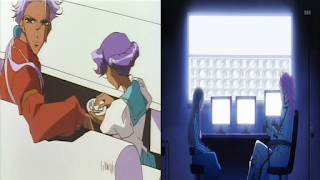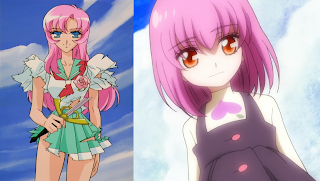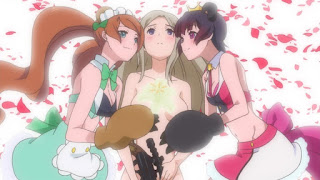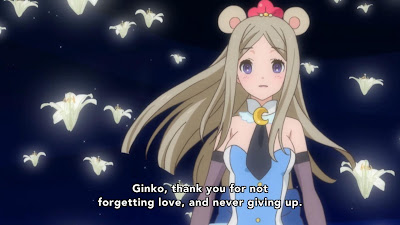A few days ago, gay marriage was made legal all over my home country, the United States, something that has put me in a highly good mood the past few days. And I'm in the mood for celebration.
If you follow my tumblr, then you'd notice that I made a post with a bunch of cannon lesbians in anime and cartoons, and I want to take a little time on the blog to celebrate my favorite LGBT gals (aside from Uranus and Neptune, as I haven't watched Sailor Moon in ages).
Utena Tenjou and Anthy Himemiya
Revolutionary Girl Utena

Utena, as one of my favorite animes, has a special place in my heart, both for its deconstruction of prince fairytales and its story of a young girl helping another escape an abusive relationship that she, herself, was too scared to leave. The relationship in the anime may have only been subtle, with small hints towards a romance between these two, but it was obvious just how Anthy and Utena felt toward one another, especially with the hand-holding and Utena filling the role as Anthy's knight in shining armor. What really made the couple canon, however, was the movie, in which the two happily and openly share kisses with one another at the end. The two go through a lot, both in the TV series and movie, including heartbreak and betrayal, and so it makes it all the more satisfying to see them be able to actually be together at the end of all of it.
Garnet
Steven Universe
 Garnet is literally the walking ship, the Holy Grail of shippers everywhere. As a fusion of the two lovebirds, Ruby and Sapphire, Garnet is the embodiment of love everywhere. Though Garnet has only been unfused for less than one half of an episode, it's clear to see just how much Ruby and Sapphire love and adore one another, and the two so far have managed to be the only gay couple on in an American children's cartoon to make their romantic relationship clear and non-debatable. And, though gems are technically non binary, they both use female forms and pronouns, so I'm more than willing and happy to include the tiny gay space rocks on this list.
Garnet is literally the walking ship, the Holy Grail of shippers everywhere. As a fusion of the two lovebirds, Ruby and Sapphire, Garnet is the embodiment of love everywhere. Though Garnet has only been unfused for less than one half of an episode, it's clear to see just how much Ruby and Sapphire love and adore one another, and the two so far have managed to be the only gay couple on in an American children's cartoon to make their romantic relationship clear and non-debatable. And, though gems are technically non binary, they both use female forms and pronouns, so I'm more than willing and happy to include the tiny gay space rocks on this list.
Sayaka Miki and Kyoko Sakura
Puella Magi Madoka Magica
 Now this one, I can see being debated over, but I hold firm in the belief that these two have feelings for one another, as the yuri undertones in this show are far from a secret. Kyoko and Sayaka came a long way, from enemies to very close, hand-holding-and-naked-abstraction-embracing "friends", and Kyoko's understanding and support as Sayaka falls into depression becomes heartbreaking when you realize that things changed between the two much too late for there to be any help. At the very least, Rebellion managed to give us a heart-warming exchange between the two, in which Sayaka expresses her regret at leaving Kyoko behind and a quick scene of them holding hands. With any luck, the next Madoka Magica movie (Because they need one in order to answer the questions posed by the end of Rebellion) will expand upon their relationship once more and possibly even give the final nudge to make these two totally and completely canon.
Now this one, I can see being debated over, but I hold firm in the belief that these two have feelings for one another, as the yuri undertones in this show are far from a secret. Kyoko and Sayaka came a long way, from enemies to very close, hand-holding-and-naked-abstraction-embracing "friends", and Kyoko's understanding and support as Sayaka falls into depression becomes heartbreaking when you realize that things changed between the two much too late for there to be any help. At the very least, Rebellion managed to give us a heart-warming exchange between the two, in which Sayaka expresses her regret at leaving Kyoko behind and a quick scene of them holding hands. With any luck, the next Madoka Magica movie (Because they need one in order to answer the questions posed by the end of Rebellion) will expand upon their relationship once more and possibly even give the final nudge to make these two totally and completely canon.
Asami Sato and Korra
Avatar: The Legend of Korra
 The Legend of Korra made a landmark on the LGBT community with its final episode, where it was revealed that the finalized pairing was not, thankfully, Korra and Mako but Korra and Asami, making it the first children's TV series with bisexual main characters. I'll admit that even I had not seen the pairing coming initially because I was trained to see female-female relationships as friendship rather than anything else, but upon reviewing the series from season two onward, I saw that the relationship between these two was very genuine and well constructed (or, it was a planned much more carefully than Korra's initial relationship with Mako, that is). The only downside was how ambiguous the ending to the show was, ending in a debate between fans that was forced to be settled later by the creators of Korra explicitly stating that Korra and Asami are a canon couple.
The Legend of Korra made a landmark on the LGBT community with its final episode, where it was revealed that the finalized pairing was not, thankfully, Korra and Mako but Korra and Asami, making it the first children's TV series with bisexual main characters. I'll admit that even I had not seen the pairing coming initially because I was trained to see female-female relationships as friendship rather than anything else, but upon reviewing the series from season two onward, I saw that the relationship between these two was very genuine and well constructed (or, it was a planned much more carefully than Korra's initial relationship with Mako, that is). The only downside was how ambiguous the ending to the show was, ending in a debate between fans that was forced to be settled later by the creators of Korra explicitly stating that Korra and Asami are a canon couple.
Princess Bubblegum and Marceline the Vampire Queen
Adventure Time
While their relationship will never be able to be explained in the show itself due to it airing in countries where it is illegal, creators of Adventure Time have revealed that Bubblegum and Marceline did date at one point in time, which actually does make a lot of sense when you look at how the two interact with one another. There did seem to be a bit of a tension between the two for a while, like ex-lovers trying to get over the break-up and just act normal for a while, and while it does look like the two have now moved on, there still seem to be some small signs of affection. Bubblegum keeping Marceline's shirt for such a long time, in particular, stands out as being rather sweet, considering how Bubblegum usually is with, well, literally anything. It's really nice to see the two getting along now.
One thing that I noticed while compiling a list of canon gay couples, however, was that there were no male couples that were to be taken seriously (in American cartoons). None that came to mind, at least. While America has come a long way in equality and representation, this does stick out as a flaw and shows us that we still have a long way to go. Hopefully we can get a few more gay couples in children's cartoons in the coming years. There are a lot of people sour about the legalization of gay marriage, and I think that sliding some exposure and representation into cartoons will at least help the younger generation understand the importance of sexual orientation and equality.
Congrats to anyone in the LGBT community who may not have been able to marry before now, and may everyone have a great day!

































